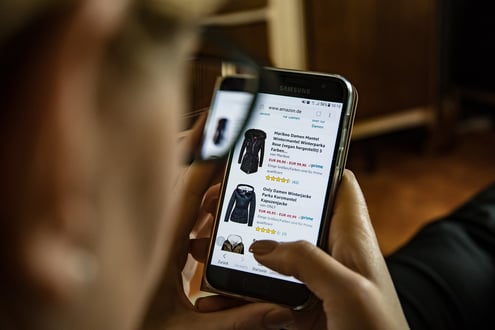In recent years, it has become common to see millions of women around the world take to the streets on March 8 to commemorate International Women's Day, demanding rights, supporting victims of gender violence and recognizing the struggle of many among them. And, although this year may be no exception in some places, in many others different initiatives have emerged owing to the current situation of the pandemic, for example inviting different types of "online action", such as the use of certain hashtags or filters to upload photographs to social networks.
But in order to speak about women and the internet we need, just as for many other cases, a closer analysis. Thus, here at Netquest we want to pay our own tribute to all women, with the best of what we have, data. Because “what is not named does not exist”.
What do International Organizations say about it?
 The United Nations Sustainable Development Goals include an important commitment to use information and communication technologies (ICTs) to promote the empowerment of women, as well as to connect people in less developed countries to the internet for 2020. However, so far, little progress has been made in reducing the “digital divide” between men and women in the use of the Internet and other ICTs.
The United Nations Sustainable Development Goals include an important commitment to use information and communication technologies (ICTs) to promote the empowerment of women, as well as to connect people in less developed countries to the internet for 2020. However, so far, little progress has been made in reducing the “digital divide” between men and women in the use of the Internet and other ICTs.
For example, a recent report by the organization Web Foundation notes that women are 50% less likely to be online than men in the same age group and with similar levels of education and family income. Women are as likely as men to have their own cell phone, but are three times less likely than men of a similar age, educational level, and economic position to use their phones to access the Internet.
Similarly, the way in which people use the Internet, once they are connected, is also strongly influenced by offline inequalities. The majority of people in poor urban areas experience greater marginalization in civil and economic life. Only a small minority actively seeks information via any medium on issues that are key for the exercise of their rights, and an even smaller percentage participates in political debate or community affairs. Most have precarious, informal jobs or have no reliable income of their own. Being a woman deepens exclusion in each of these aspects.
In particular, women who are active in political and civic life "offline" are not only more likely to be online, but also three times more likely (depending on education, age and income) to use the Internet to express opinions on important or controversial issues than other women.
#NetquestData on our female panelists
So, now that we have a very general overview of the situation regarding women and internet access, we ask ourselves a basic question: What do women do on the internet, what sites do they visit? And in order to reach an answer, we would like to share with you some data from our female panelists in Brazil, Spain and Mexico. Naturally, for this exercise, we have collected behavioral data from their online browsing.
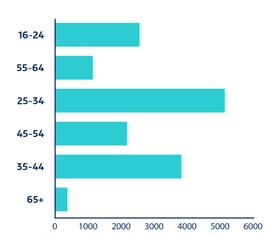 The sample of premium panelists that we have taken is made up of the following: 15234 women, of which 5076 are from Brazil, 5196 from Mexico and 4962 from Spain. We tracked their browsing between January 01 and 31, 2021 via any device (mobile, desktop computer, laptop). The largest age group in our sample was that of the 25 to 34 year olds, with a total of 5142 panelists, followed by 35 to 44 year olds with 3,829, then 16 to 24 year olds with 2,559, and 45 to 54 year olds with 2,183. The age group with the fewest panelists is those over 65, with just 376.
The sample of premium panelists that we have taken is made up of the following: 15234 women, of which 5076 are from Brazil, 5196 from Mexico and 4962 from Spain. We tracked their browsing between January 01 and 31, 2021 via any device (mobile, desktop computer, laptop). The largest age group in our sample was that of the 25 to 34 year olds, with a total of 5142 panelists, followed by 35 to 44 year olds with 3,829, then 16 to 24 year olds with 2,559, and 45 to 54 year olds with 2,183. The age group with the fewest panelists is those over 65, with just 376.
Unique visitors to websites
It is no secret that the internet comprises an almost infinite amount of information, and that those of us who use it do so in different ways and for different reasons: work, entertainment, shopping, education... We are confronted with endless possibilities and options when opening any browser. However, there are a few large sites or portals that receive a huge number of unique visitors among Internet users. What are the 10 sites that the panelists in our sample visited the most?
The first is “google.com” (unsurprisingly) with 13,025 unique visitors over a month. On the winner's podium, they are followed by "facebook" with 9576 and "youtube" with 8191. To view the rest of the list, you can check the following graph:
Chart: Top 10 Sites vs. number of unique visitors
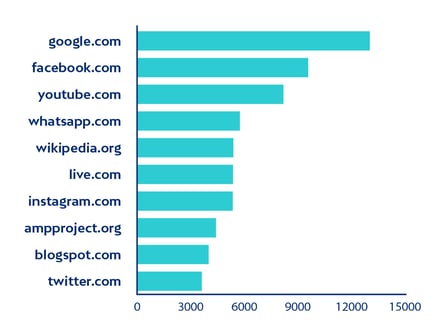
News and information sites
With the world in constant and dramatic change, and with a huge wave of women aware and willing to demand the fulfillment of their rights, and who are taking on new and different roles inside and outside of their homes, it was interesting for us to find out which news and information sites received the most unique visitors in the sample.
"Yahoo.com", "globo.com" and "uol.com.br" take the top three places, with 2740, 2723 and 2515 respectively. It is notable that second and third place correspond to sites in Brazil, and it would be interesting to delve into this topic further in the future and ask ourselves whether Brazilian women are really more “informed” than Spanish or Mexican women.
Chart: Top 10 News Sites vs. number of unique visitors
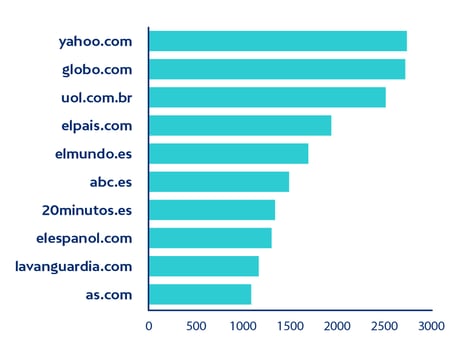
Entertainment sites
But there is more to life than work and staying informed, whether outside or inside the home. Leisure and recreation time have become increasingly important in recent years, not to mention this year when we have been in lockdown. Whether for ourselves or for some other member of the household (such as children), owing to the impossibility of going out as easily as before or simply out of a love of cinema, streaming sites have found a very special place in our daily lives.
Our panelists mostly visited “youtube.com”, “netflix.com” (yes, it's in second place) and “primevideo.com”. An interesting fact is that "spotify.com" is the only music-only streaming site that appears on the list.
Chart: Top 10 Entertainment Sites vs. number of unique visitors
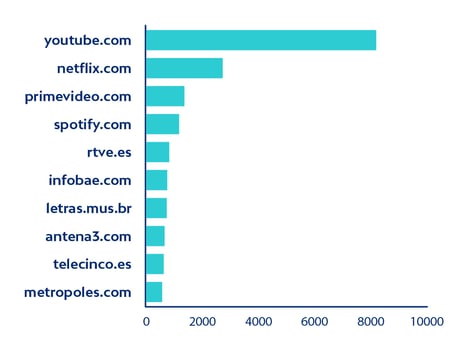
Online shopping sites
Sociology maintains that a social event or phenomenon is multi-causal, that is, that it has more than one cause, and if we follow this assumption, we could say that it is not only confinement due to the pandemic which has been the great driver of online shopping. Although via small and uneven steps, many women around the world have found greater access to education, which provides them with opportunities to find better-paid jobs and increase their purchasing power.
“Amazon.es” with 3,182 unique visitors “aliexpress.com” with 2,690 and “amazon.com” with 2,636 are the first three sites in this category. In fact, 4 of the 10 most visited sites correspond to Amazon, in terms of market share...
Chart: Top 10 Shopping Sites vs. number of unique visitors
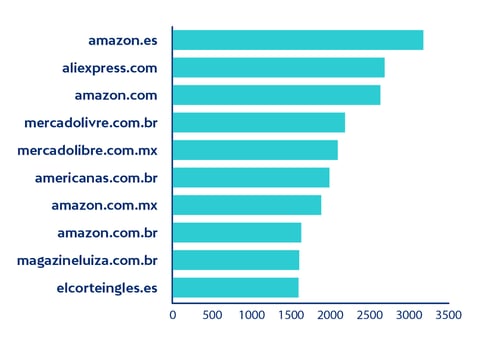
Adult content sites
Last but not least, we dedicated a space to the online consumption by our sample of female panelists of sites with adult content. We believe that it is not a kinky or "curious" fact, but rather a piece of information that could reflect, among many other things, that women are appropriating their sexuality. In other words, that they no longer see in this type of content something "only for the enjoyment of men", rather that now they are the ones who make decisions about themselves and their bodies. What do you think? We are the experts as far as the data is concerned, the interpretation is up to you.
"Xvideos.com" is in first place with 1176 unique visitors, with a long distance to second place for "pornhub.com" with just 648 and then "xnxx.com" with 568 unique visitors.
Chart: Top 10 Adult Content Sites vs. number of unique visitors
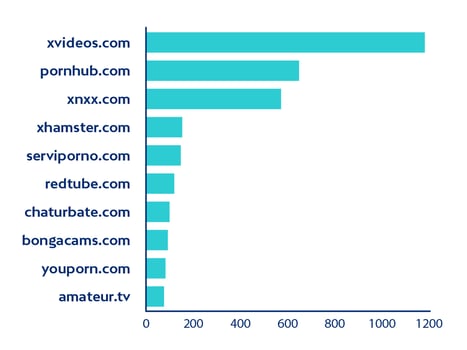
In conclusion, for now, we reiterate the phrase "what is not named, does not exist", to invite you all to continue to get to know women in their great diversity. Our panelists, as well as the rest of the women in the world, change day by day, as do their habits, values and ideas. Let's respect them all, let's take care of them all.





